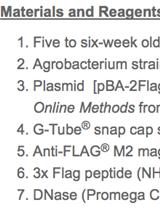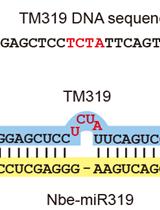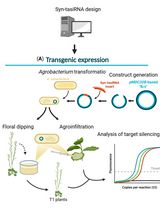- EN - English
- CN - 中文
A High Resolution Short Interfering RNA (siRNA) Detection Method from Virus-infected Plants
高通量检测病毒感染植株中siRNA
发布: 2013年10月20日第3卷第20期 DOI: 10.21769/BioProtoc.940 浏览次数: 13310
评审: Tie Liu
Abstract
Plant viruses are strong inducers as well as targets of RNA silencing. In plants RNA silencing acts as a natural defense mechanism against viral infection and is associated with accumulation of virus-specific small interfering RNAs (siRNAs). The continuing discoveries, increasing awareness and interest in the regulatory roles of non-coding small RNAs have raised the need for methods that can reliably detect and quantitate the expression levels of small RNAs. Northern blot analysis of small RNAs involving the separation of RNA molecules using polyacrylamide gel electrophoresis (PAGE) has remained a popular and valuable analytical method to validate small RNAs. Northern blot analysis consist of resolving RNAs by gel electrophoresis, followed by transferring and fixing to nylon membranes as well as detecting by hybridization using radioactive probes. The following protocol provides a method for isolation and detection of small RNAs from virus-infected plants and was successfully used in Panwar et al. (2013a), Panwar et al. (2013b).
Keywords: RNA Silencing (RNA沉默)Materials and Reagents
- Virus-infected plant tissue
- TRIzol reagent (Invitrogen)
- Chloroform (Sigma-Aldrich)
- Isopropanol (Sigma-Aldrich)
- Ethyl alcohol (EtOH)
- Diethylpyrocarbonate (DEPC) (Sigma-Aldrich)
- Hybond NX Neutral Membrane (Amersham biosciences, catalog number: RPN203T )
- 40% Acrylamide/N’N’-bis-methylene-acrylamide (19:1) (Life Technologies, Ambion®)
- Tetramethylethylenediamine (EDTA) (Sigma-Aldrich)
- Urea (Sigma-Aldrich)
- Hyperfilm TM MP (Amersham biosciences, catalog number: 28-9068-45 )
- Ethidium bromide (Sigma-Aldrich)
- Ethyl-3-(3-dimethylaminopropyl) carbodiimide (EDC) (Sigma-Aldrich, catalog number: 39391 )
- Ammonium persulphate (APS)
- Tetramethylethylenediamine (TEMED) (Sigma-Aldrich)
- Tris base (AMRESCO)
- Boric acid (Fisher Scientific)
- Formamide (Sigma-Aldrich)
- Bromophenol blue (Sigma-Aldrich)
- Xylene cyanol (Sigma-Aldrich)
- 3 MM Whatman filter paper
- 1-methylimidazole (Sigma-Aldrich)
- Hydrochloric acid (HCl)
- Sodium dodecyl sulphate (SDS) (Fisher Scientific)
- 20x Saline sodium citrate (SSC) buffer (Sigma-Aldrich)
- ULTRAhyb-Oligo buffer (Life Technologies, Ambion®, catalog number: AM8669 )
- Megaprime DNA Labeling System (General Electric Company, model: RPN1604 )
- Liquid nitrogen
- RNase-free water
- Small gels (size of regular protein gels 1.5 mm thick) (Bio-Rad, Mini-Protean® Cell)
- Neutral Hybond nitrocellulose membrane
- RNase ZAP (Life Technologies, catalog number: AM9784 )
- DEPC treated water (see Recipes)
- 10x Tris-Borate-EDTA (TBE) buffer (see Recipes)
- 10% APS (see Recipes)
- 15% polyacrylamide gel (see Recipes)
- 2x loading buffer (see Recipes)
Equipment
- Pestle and mortars
- Semi dry electroblotter (Bio-Rad)
- Protean II vertical gel system (Bio-Rad)
- Nanodrop spectrophotometer
- Centrifuge
- Hybridization oven
- UV transilluminator
- Microcentrifuge tube
- Electrophoresis apparatus
- X-ray film
Procedure
文章信息
版权信息
© 2013 The Authors; exclusive licensee Bio-protocol LLC.
如何引用
Panwar, V. and Bakkeren, G. (2013). A High Resolution Short Interfering RNA (siRNA) Detection Method from Virus-infected Plants. Bio-protocol 3(20): e940. DOI: 10.21769/BioProtoc.940.
分类
植物科学 > 植物分子生物学 > RNA > RNA 干扰
植物科学 > 植物免疫 > 信号感知与传递
分子生物学 > RNA > RNA 干扰
您对这篇实验方法有问题吗?
在此处发布您的问题,我们将邀请本文作者来回答。同时,我们会将您的问题发布到Bio-protocol Exchange,以便寻求社区成员的帮助。
Share
Bluesky
X
Copy link














